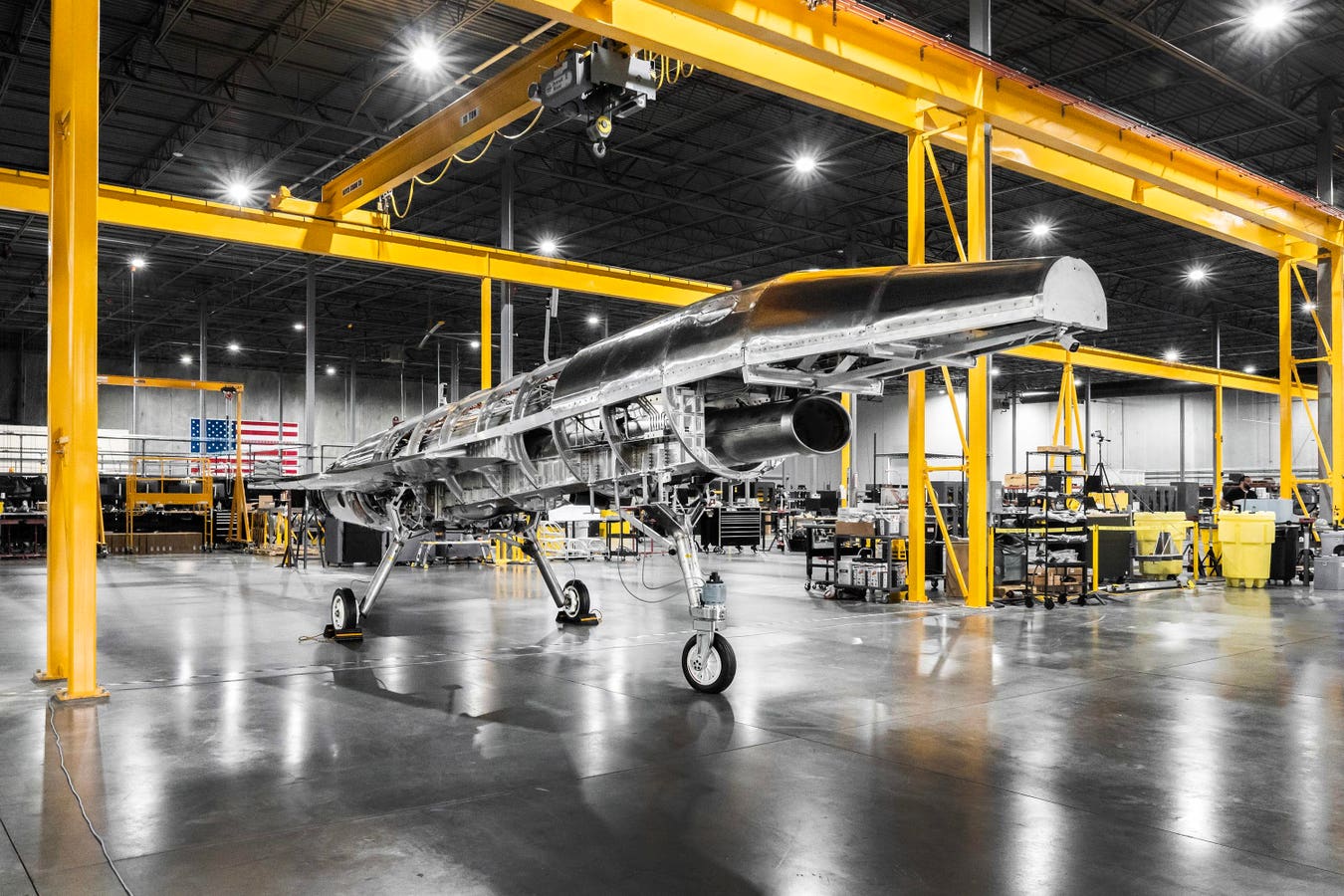Thoroughbred race-horses warmup with a walk, a trot and a canter. Hypersonic vehicle builder Hermeus will warm up its Quarterhorse prototype with a dedicated ground test vehicle.
Called Quarterhorse Mk 0 by the company, the ground bound test article or “Iron Bird” is a nearly 40-foot long representation of the flight test vehicle – Quarterhorse Mk 1 – that the company will launch into the skies when testing commences next year.
Mk 0 is more than just a ground-test asset of course. It’s something physical to show investors (both private and government), a marker of progress on the way to a flyable subscale hypersonic demonstrator.
“That’s how we see it as well,” Hermeus CEO A.J. Piplica agreed during a phone interview. “It’s not a major milestone where we’ve reduced a significant risk like we did with the [engine turbojet to ramjet] transition testing last year but it’s real step forward no less.”
It’s a shiny step forward as seen in the photo above with polished aluminum skin looking like a throwback to the X-aircraft of the 1950s and 1960s that Piplica is fond of citing as experimental inspirations. He suggests Hermeus is not alone. “I think Elon [Musk] was pretty famous for wanting all the [SpaceX] Merlin booster engine nozzles polished after acceptance testing so they’d look nice on the [launch] pad.”
What you see in the photo is what Mk 0 will look like in ground testing, no wings or other aero features will be added. The Iron Bird will have an engine but it won’t be the Chimera turbine-based combined cycle (TBCC) engine that it will use to propel Quarterhorse to hypersonic velocity. Instead it incorporates the General Electric J85-21 engine (which powers the small Northop F-5E/F fighters) it will use for initial flight testing.
The package will demonstrate remote command and control during taxiing using Hermeus’ in-house designed “Flight Deck” command and control system. “It’ll be taxi-testing up to the point where we’ve integrated all the structure, avionics, propulsion, fluids, software and our Flight Deck,” Piplica says.
The tests will set a foundation for ground ops during flight test program. The data gathered (inlet, engine, power systems performance) is a minor emphasis. Hermeus’ CEO says the “real value” lies in building up what he calls “the machine that builds the machine.”
In essence, he means the support structure behind the aircraft and the engineering that has gone into it – the company’s business and systems integration processes. “We’ve built those, we’ve exercised them, we’ve gained lessons-learned from taking a vehicle through the full build using processes that were quite nascent four months ago. Today, they’re mature.”
Ground testing also allows Hermeus – a company with no previous flight testing or FAA certification process experience – to interact with other organizations and with aircraft traffic on the ground at its home Dekalb-Peachtree Airport near Atlanta to hone its remotely-piloted aircraft (RPA) system before going aloft.
Flight Deck is not just the command and control software but an operations and computing center housed in a climate-controlled intermodal shipping container that supports a pilot, payload operator, four operational analysts, and multiple jump-seats for observers.
It is built to DoD secure-room standards allowing for turn-key open-storage, video conferencing, and operations. These will be handy when Quarterhorse begins flight testing at a restricted site likely far away from its headquarters facilities.
The ground tests should be complete by year’s-end and will be relatively low-key though potential customers and supporters like the Air Force’s AFWERX tech development arm will have observers on hand.
Hermeus investors will get a bit of a preview via the company’s newsletter and in monthly investor meetings Piplica hosts. He acknowledges that the build and pending taxi-testing of Mk 0 has increased investor interest. Thus far, the company has brought in approximately $190 million in private and government/Pentagon investment.
“For deep-tech in general, when you’re able to demonstrate moving the ball forward on technical de-risking, operations, [new] customer contracts or in the pure physics realm, they drive future rounds of investment, certainly.”
Fundraising could get a further boost if the unmanned Quarterhorse can be yoked to other applications. It takes little imagination to look at the aircraft, consider its RPA system and GE engine, and recognize it as a potential Collaborative Combat Aircraft (CCA) platform.
The Air Force’s recent request for information on higher thrust powerplants for CCAs tilts nicely in Quarterhorse’s direction. Could it be put forward for such a role?
“It’s certainly possible,” Piplica affirms without elaborating.
But Quarterhorse’s reusable hypersonic test capability is attractive enough on its own he stresses. The Air Force’s air-launched, ramjet-powered X-51A Waverider hypersonic vehicle experiments cost roughly $450 million and yielded less than ten minutes of flight data Piplica notes. DARPA’s Advanced Full Range Engine (AFRE) program cost is classified.
Expected to fly next year, Quarterhorse, and the sub-$200 million thus far spent on it looks like a “fantastic deal for the taxpayer” in comparison Piplica reasons. We’ll only know for sure when and if a Quarterhorse Mk 4 successfully demonstrates an in-flight turbojet-to-ramjet transition and breaks the reusable aircraft airspeed record.
The next few months will only see it walk, trot and canter.
Read the full article here





